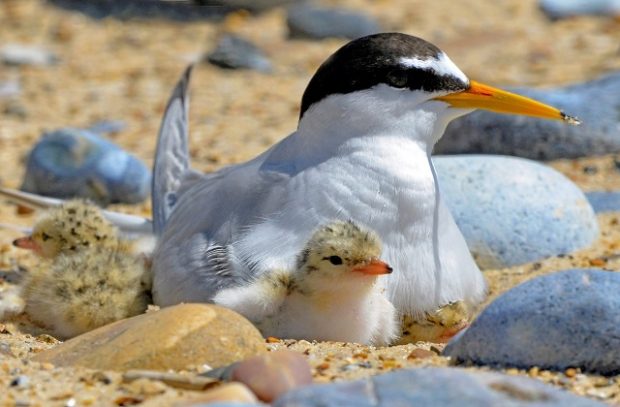
The UK’s second rarest shorebird has had a bumper breeding season, with 17 little tern juveniles fledging at Lindisfarne National Nature Reserve this season.
Little terns travel from West Africa to Northumberland every breeding season, with rangers closely monitoring them for the best chance of boosting the count of these small but mighty birds.
The rangers this year monitored five nesting sites for both little terns and ringed plovers. Both species have seen declines in their breeding population in the UK in past years, with a major factor being human and dog disturbance.
The resulting 17 young little terns are the only known fledglings between Aberdeen and Norfolk.
Warden Ceris Aston works on site and has written a first person account of breeding season on the reserve.
It is the end of shorebird season. The signs and fences have been removed, the netting rolled up, our small warden’s hut taken away – and we look out upon just another stretch of beach, indistinguishable from that 100 metres to the north or to the south. For the past three months, this small area of dune, sand and sea has been the centre of our hopes, thoughts and fears.
Happily, efforts of reserve staff and volunteers, and the co-operation of walkers, have enabled these charismatic birds a small window of space and time to court, lay eggs, and rear chicks and fledglings.
The sites have seen some high drama. Fish-waggling courtship, love triangles, high-speed aerial battles, tempests, flooding, mortal peril. Shakespeare couldn’t write it better. Our little terns will soon farewell the Northumberland coast, making their way back towards West Africa for the winter. With the adults will fly an additional 17 juveniles, making the journey for the first time. The ringed plovers may move south or choose to overwinter here – but they too have grown in number; with new fluffy pom-poms becoming doughty fledglings. This is what we have been working towards.
It’s a strange feeling; the end of shorebird season. Our gaze, so tuned in to these small areas of beach, expands – the reserve has 3,500 hectares, covers 65km of coastline. Soon the geese and waders will come to overwinter here – 50,000 migratory wildfowl will fill the reserve. We stack the fence poles in the reserve yard, untangle the netting and roll it up neatly. Some will be used this autumn, as we graze the dunes with sheep leased from a local farmer. We empty sand from our pockets and our shoes; look forward to the next chapter of life on the reserve.”
Lindisfarne National Nature Reserve – which covers 3,500 hectares – is host to a number of habitats including intertidal mudflats, rocky shores, sand dunes and saltmarsh.
Natural England works to ensure that the birds and plants of the area continue to survive in harmony with each other and the people who live and visit here.